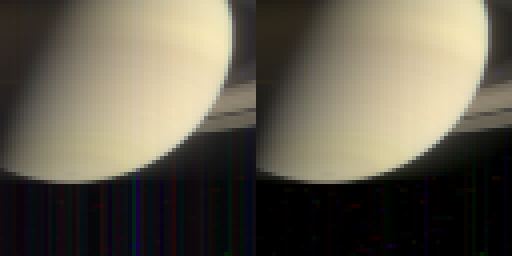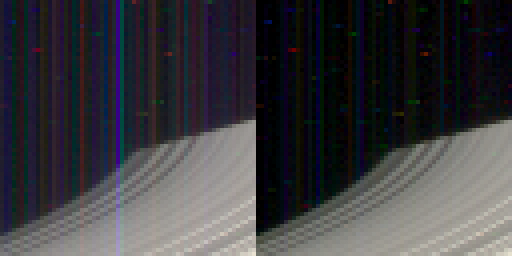Processing VIMS cubes, An attempt at "true" color |

Processing VIMS cubes, An attempt at "true" color |
 Sep 10 2006, 07:51 PM Sep 10 2006, 07:51 PM
Post
#1
|
||||||||
 Senior Member     Group: Members Posts: 3648 Joined: 1-October 05 From: Croatia Member No.: 523 |
Right, a suggestion I made here in another topic made me wonder why not try that myself. A bunch of data was sitting on the PDS, after all. After a hassle figuring out just how the image cubes are organized and trying to read them, finally I was able to produce some results. This is all very rough work, can be considered first-iteration only and not particularly accurate.
Basically, I used the cubes to extract the visible spectrum in the 380-780 nanometer range which was then input to color matching code I found here by Andrew T. Young. The code integrates over 40 10-nm steps to produce CIE XYZ color components. I then converted these to RGB values. I'm aware of at least three inaccuracies in my code as of yet: one is the above sampled code apparently uses Illuminant C as the light source, not true solar spectra so the color turns out bluish (has a temp. of 9300 K instead of 6500 K, AFAIK). I tried to compensate at the moment by changing the final RGB white balance, but this is probably an inaccurate way to go. Another inaccuracy is I don't do bias removal from the cubes. This likely affects the outcome. Also, I don't use the precise wavelengths the code requires, but use the closest one in the cube. I intend to fix this by interpolating between nearest wavelengths. All images are enlarged 4x. The leftmost image is a 4-cube mosaic. The colors in all four frames turned out identical which gives me at least some confidence. The image in the middle shows Dione's disc creeping in front of Saturn. Dione's disc appears elongated probably because as the lines were readout, it moved considerably in its orbit. The rightmost image shows a very overexposed Saturn image, the part below the ring shadows got overexposed. From what I've seen browsing through the PDS, a lot of the cubes are badly overexposed at some wavelengths. Here's a couple of Jupiter images. I'm not very satisfied with them as they seem to look somewhat greenish, but overall the color looks believeable: Lastly, two Titan composites. They turned out way more reddish than I thought they would. It'll be interesting to see how much the results will change once I do a more proper processing pipeline working. -------------------- |
|||||||
|
|
||||||||
 |
 Sep 22 2006, 09:12 PM Sep 22 2006, 09:12 PM
Post
#61
|
|
 Interplanetary Dumpster Diver     Group: Admin Posts: 4404 Joined: 17-February 04 From: Powell, TN Member No.: 33 |
For Jupiter and Saturn, I am biased toward the right hand images based on experiences with a telescope, but this brings in a whole new host of visual issues...
-------------------- |
|
|
|
 Sep 25 2006, 08:02 PM Sep 25 2006, 08:02 PM
Post
#62
|
|
 Senior Member     Group: Members Posts: 3648 Joined: 1-October 05 From: Croatia Member No.: 523 |
I've been experimenting with cleaning up the VIMS visual channel a bit. I've found a cube that captures the night side of Titan with the entire 64x64 hires field of view that served as an augmented dark background to remove the pesky noise. It turned out better than I hoped. Unfortunately, the noise doesn't seem to be as static as I thought. Most of the noise is removed, but some isn't.
To illustrate just what mess the VIMS cubes are (including their calibration data), here are a couple of before and after images:    The bottom image is one of the highest resolution views of Iapetus by VIMS. The noise is disastrous. You can actually see it's mostly coincident with the ring image above. My dark current removal model assumes noise is linear with exposure, this seems to work well. The background will need some touching up still. I emailed one of the guys responsible for the PDS volumes, he said he'll look into it and get back to me. We shall see, though I'm not getting my hopes up. -------------------- |
|
|
|
 Sep 26 2006, 07:33 AM Sep 26 2006, 07:33 AM
Post
#63
|
|
 Senior Member     Group: Members Posts: 3648 Joined: 1-October 05 From: Croatia Member No.: 523 |
Sure enough, I got a response from the VIMS team. They had this to say:
QUOTE New dark models have not been generated with regularity and users of the VIS science data have been doing corrections after the calibration pipeline by looking at average values along columns in data and using these values to correct their data. That doesn't sound like a very exact science, though. -------------------- |
|
|
|
 Sep 26 2006, 09:49 AM Sep 26 2006, 09:49 AM
Post
#64
|
|
|
Senior Member     Group: Members Posts: 1870 Joined: 20-February 05 Member No.: 174 |
It probably boils down to too-much-to-do, not-enough-techies, not-enough-grad-students...
The sort of thing that pennypinching does to a live mission. They'll have time for a systematic beginning-to-end calibration effort when the mission is over. |
|
|
|
 Sep 26 2006, 02:27 PM Sep 26 2006, 02:27 PM
Post
#65
|
|
 Senior Member     Group: Members Posts: 3648 Joined: 1-October 05 From: Croatia Member No.: 523 |
To reiterate what you said, on my asking if updated calibration data will be provided, he said that will happen at the end of Cassini mission. An earlier update may be possible, but not likely.
Guess that means I'm stuck with homebrewn dark current models <sigh>... -------------------- |
|
|
|
 Oct 4 2006, 05:55 PM Oct 4 2006, 05:55 PM
Post
#66
|
|
 Senior Member     Group: Members Posts: 3648 Joined: 1-October 05 From: Croatia Member No.: 523 |
Here are a few quick results from the new PDS release. Not that much interesting stuff in there this time. These don't have the sRGB correct gamma of 2.2 because it just looks too washed out to me and it really brings the nasty vertical noise out. I chose a gamma of 1.33 instead. Magnified 2x.
 The first image is coincident with an ISS wide-angle shot. The 3rd image from the left shows the F ring, the 4th shows Titan's north pole at high phase. The Saturn mosaic has one of the moons visible at the bottom - might be Dione/Tethys/Rhea, I haven't checked. The last image was taken during that Titan flyby where we had Saturn emerging from behind Titan's limb. You can barely see part of Saturn's crescent there, too bad the view didn't capture more of it. -------------------- |
|
|
|
 Oct 11 2006, 11:53 AM Oct 11 2006, 11:53 AM
Post
#67
|
||||||||
 Member    Group: Members Posts: 239 Joined: 20-April 05 From: Bruxelles, Belgium Member No.: 278 |
First test to process VIMS cube ( gamma 2.2 )
v1509053994_1 color thumbnails v1509133941_1 color thumbnails v1509134411_1 color thumbnails and a small screenshot of my software ( perharp a release un some days .. or weeks -------------------- |
|||||||
|
|
||||||||
 Feb 18 2011, 10:20 PM Feb 18 2011, 10:20 PM
Post
#68
|
|
 Administrator     Group: Admin Posts: 5172 Joined: 4-August 05 From: Pasadena, CA, USA, Earth Member No.: 454 |
Hey folks, the Rings Node has generated preview images for Cassini VIMS cubes to their OPUS search tool. The attached screen cap shows what these look like for a colorful object, Iapetus. Here's an explanation by Mark Showalter of what the preview images show. This will make it much easier to browse for good VIMS data!
-------------------- My website - My Patreon - @elakdawalla on Twitter - Please support unmannedspaceflight.com by donating here.
|
|
|
|
 Apr 28 2011, 09:27 PM Apr 28 2011, 09:27 PM
Post
#69
|
|
|
Senior Member     Group: Members Posts: 3516 Joined: 4-November 05 From: North Wales Member No.: 542 |
A superb piece of work at TPS but we have to have it here too.
http://www.planetary.org/image/2383059379_c56b0272cb_o.png Believable true colour is a great gift. Thank you Gordan. |
|
|
|
  |

|
Lo-Fi Version | Time is now: 1st June 2024 - 02:07 AM |
|
RULES AND GUIDELINES Please read the Forum Rules and Guidelines before posting. IMAGE COPYRIGHT |
OPINIONS AND MODERATION Opinions expressed on UnmannedSpaceflight.com are those of the individual posters and do not necessarily reflect the opinions of UnmannedSpaceflight.com or The Planetary Society. The all-volunteer UnmannedSpaceflight.com moderation team is wholly independent of The Planetary Society. The Planetary Society has no influence over decisions made by the UnmannedSpaceflight.com moderators. |
SUPPORT THE FORUM Unmannedspaceflight.com is funded by the Planetary Society. Please consider supporting our work and many other projects by donating to the Society or becoming a member. |

|